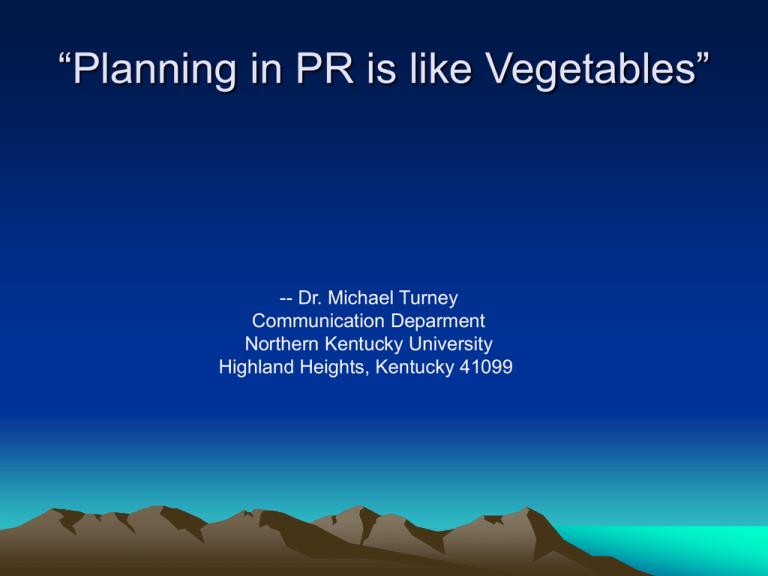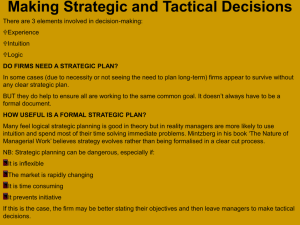“Planning in PR is like Vegetables”
advertisement

“Planning in PR is like Vegetables” -- Dr. Michael Turney Communication Deparment Northern Kentucky University Highland Heights, Kentucky 41099 "Planning is good for you!" At one time or another, probably from your mother, you've heard: "You should eat more vegetables. They're good for you; they'll make you healthy." You probably even believe it, or at least accept it as reasonable conventional wisdom, but that doesn't mean you eat as many vegetables as you should. Nor does it make you to like them. A similar observation can be made about public relations planning. At one time or another, probably at a conference or workshop, most public relations practitioners have heard: "You should do more planning. It's good for you; it will make you more successful." Most practitioners probably believe it. Some even bemoan not having more time to devote to planning, but that doesn't mean they do as much planning as they should. Nor does it mean they like planning. The fact is: public relations planning is a lot like vegetables. Planning helps clarify your intentions. • Traditional planners set goals, identify objectives, and define action steps to reach their goals and objectives. • Contemporary planners have added buzz words like strategic, visioning, and organizational advancement to the planning lexicon. They shift into an "organizational advancement mode" to draft "strategic planning documents that enunciate organizational visions." A public relations plan helps maintain selfdiscipline as well as being an excellent informational tool. This is especially true for public relations practitioners who have recently changed jobs or taken on new clients. Planning forces them to ask questions and review their underlying assumptions. Each successive step in the planning process sharpens their focus on how the organization operates and where it's going, as well as clarifying public relations' role in that operation. Sometimes "quick and dirty" planning is all that's needed. However, the most effective planning is slower and more methodical. Despite its current overuse, the term "strategic" still has important meaning for planning, especially when it's used in the traditional sense to distinguish strategic planning from tactical planning. • Strategic planning defines an overall framework, focus, and goals for a longterm or indefinitely on-going process or operation. • Tactical planning is an outgrowth of strategic planning that often focuses on a specific time period, e.g., a five year plan, an annual plan, or a monthly plan, rather than the entire life of the organization. The best public relations practitioners are equally comfortable doing both types of planning. They work together. Think of an organization's strategic plan as its global view of the world and its tactical plan as its local street map. The tactical plan converts the broad brush strokes and goals of the strategic plan into a series of objectives which are practical, do-able tasks involving specific campaigns, audiences, programs, or activities. Each of these tactical objective--or project--can be completed independently of the others, but they are ultimately intended to move the organization toward its long-range goals. "Tomorrow's communicators will be people who can think strategically and deliver tactically. A well-written annual report or brochure is of no strategic value if it does not contribute to meeting corporate goals and objectives." -- Keith Sheldon IABC Communication World (Oct. 1993) Planning starts with a mission statement. Target audiences can be the next focal point for planning. Beyond this point different planners structure their plans in various ways to reflect their views of what public relations is and what it does. Some put primary emphasis on policy research and issues management. Others put their emphasis on activities like publications, special events, speech writing, and media relations. And, those who see relationship-building as the essence of public relations often build their strategic plans around their organization's most important publics and target audiences. Take ten steps for a strategic public relations plan. Audience and goal identification 1. Who are the organization's key target audiences? 2. Why is this audience important to the organization? 3. What view does the organization want this audience to have of it? Reporting research findings 4. What is this audience's current view of the organization? 5. What issues and appeals are important to this audience? 6. Which media does this audience use and trust the most? Assessment and plan development 7. How does this audience's current view of the organization differ from the desired one? This is determined by comparing responses to items 3 and 4 above. 8. What message themes will have the greatest impact on this audience? These should reflect the findings from question 5 above. 9. What are the best ways of reaching this audience? These should be selected in light of the findings from question 6 above. 10. Who will serve as the organization's primary contact for working with this audience? Take five more steps for a tactical plan. Selecting and setting objectives 11. What short-term objectives will lead to the goals of the strategic plan? Actions needed to reach these objectives Answer questions 12-15 for each objective identified in 11 above. 12. What specific actions or messages will lead to achieving this objective? 13. What resources will be needed for these tasks? Identify specific people, equipment, and funds needed for each item in question 12 above. 14. When should it be done? Specify a timetable for accomplishing each item listed in 12 above. 15. How will success in achieving each objective be evaluated?





